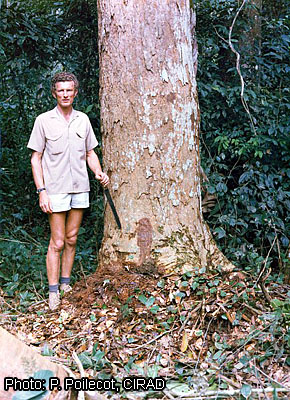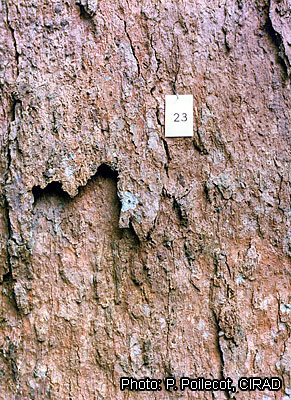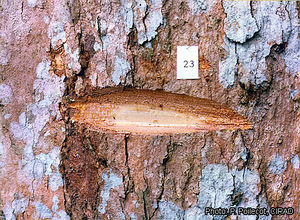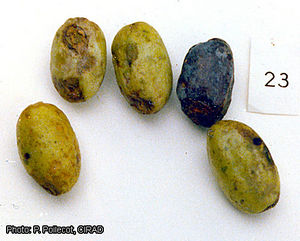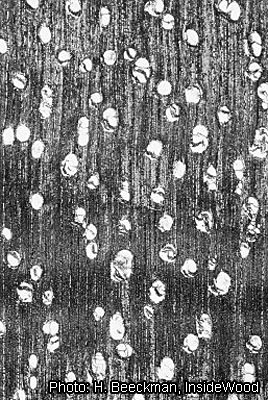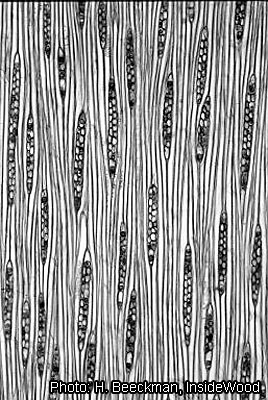Dacryodes pubescens (PROTA)
Introduction |
| General importance | |
| Geographic coverage Africa | |
| Geographic coverage World | |
| Fruit | |
| Essential oil / exudate | |
| Timber | |
| Food security | |
| Conservation status | |
Dacryodes pubescens (Vermoesen) H.J.Lam
- Protologue: Bull. Jard. Bot. Buitenzorg, ser. 3, 12: 337 (1932).
- Family: Burseraceae
Synonyms
- Pachylobus pubescens Vermoesen (1923).
Origin and geographic distribution
Dacryodes pubescens is distributed in Congo, DR Congo and northern Angola, possibly also in southern Gabon.
Uses
The wood (trade name: safukala) is recommended for furniture, screens, door and window frames, stairs and other light carpentry, flooring, construction, vehicle bodies, mine props, poles and piles. The wood is also considered suitable for ship and boat building, tool handles, agricultural implements, joinery, vats, toys, novelties, turnery, railway sleepers, veneer, core stock, hardboard and particle board. The cooked fruit is eaten. The resin has been used for torches.
Production and international trade
The wood is difficult to distinguish from the more important ‘ozigo’ (Dacryodes buettneri (Engl.) H.J.Lam), but is traded separately as ‘safukala’, together with the wood of Dacryodes heterotricha (Pellegr.) H.J.Lam. In 2004 about 1000 m³ of ‘safukala’ logs were exported from Congo.
Properties
The sapwood is pale pink, yellow or grey, and very wide, often extending over half the radius of the log; the heartwood is somewhat darker. The grain is straight or interlocked; texture medium. The wood is lustrous, and ribbon-like markings and small stripes give it an attractive figure.
The wood has a density of 610–690 kg/m³ at 12% moisture content. Seasoning should be done carefully, to avoid checking. The rates of shrinkage from green to oven dry are 4.6–5.7% radial and 6.2–9.5% tangential. Once dried, the wood is stable in service.
At 12% moisture content, the modulus of rupture is 111–163 N/mm², modulus of elasticity 10,500–12,700(–16,000) N/mm², compression parallel to grain 53–62 N/mm², cleavage 15–25 N/mm and Chalais-Meudon side hardness 3.1–6.3.
The wood saws slowly and with some difficulty, with a blunting effect on tools; the use of stellite-tipped saw teeth is recommended. It works fairly well with hand and machine tools, but rough patches may be produced on planing. It does not split on nailing and holds nails and screws well. Peeling characteristics are good, and gluing, boring and sanding properties satisfactory. The wood paints and varnishes well.
The wood is not very durable, being susceptible to attack by fungi; reports on its liability to attack by insects are conflicting. The heartwood is resistant to impregnation, the sapwood moderately resistant.
Description
- Dioecious, evergreen, medium-sized to fairly large tree up to 37 m tall; bole up to 150 cm in diameter, often sinuous; outer bark cream-pink coloured, flaking, inner bark pale pink, exuding a colourless fragrant resin when cut; crown voluminous, hemispherical, branches long and spreading; young branches rusty stellate hairy.
- Leaves alternate, imparipinnately compound with (4–)5–8 pairs of leaflets, up to 40 cm long, persistently rusty stellate hairy on petiole, rachis and petiolules; stipules absent; petiole 5–10 cm long; lateral petiolules up to 5 mm long, terminal one 15–20 mm; leaflets opposite, oblong to oblong-lanceolate or oblong-obovate, 5–20 cm × 2–7 cm, base rounded, sometimes asymmetric, apex long-acuminate, upper surface glabrous except on midvein, lower surface with persistent rusty stellate hairs, pinnately veined with 10–18 pairs of lateral veins.
- Inflorescence a panicle up to 30 cm × 4 cm.
- Flowers unisexual, regular; pedicel 1–4 mm long; calyx 3-lobed, 3–4 mm × 2–3 mm, segments ovate; petals 3, ovate, 4–5 mm × 3 mm; stamens 6, filaments c. 2 mm long; ovary ovoid.
- Fruit an oblong-ellipsoid drupe 2–3 cm × 1–1.5 cm, violet, glabrous, stone 1-seeded.
Other botanical information
Dacryodes comprises about 40 species, occurring in the American, Asian and African tropics. In Africa, about 20 species have been found, all of section Pachylobus. Gabon seems richest with approximately 10 species.
Dacryodes heterotricha
The wood of Dacryodes heterotricha (Pellegr.) H.J.Lam is very similar to that of Dacryodes pubescens and is also known as ‘safukala’, although it has also been called ‘mouganga’. Dacryodes heterotricha is a medium-sized tree up to 25 m tall, with a bole up to 100 cm in diameter, distributed in Gabon and Congo. The wood has a density of 610–760 kg/m³ at 12% moisture content. The rates of shrinkage from green to oven dry are 3.0–6.1% radial and 7.5–8.9% tangential. At 12% moisture content, the modulus of rupture is 119–201 N/mm², modulus of elasticity 10,500–15,400 N/mm², compression parallel to grain 56–74 N/mm², shear 10–14 N/mm², cleavage 25–33 N/mm and Chalais-Meudon side hardness 4.1–7.4. The fruit is edible. A decoction of the leaf is taken to treat whooping cough.
Ecology
Dacryodes pubescens occurs in lowland rainforest and along rivers, sometimes under inundated conditions.
Management
In an inventory in Cabinda (Angola) in the 1960s, an average of 11.8 trees per ha was found in an area of 16 ha, with 71% having a bole diameter of less than 50 cm, and 7% having a diameter of over 80 cm.
Genetic resources
In view of its limited distribution, there may be some danger of genetic erosion, but Dacryodes pubescens is not included in the IUCN Red list.
Prospects
It is unclear to what extent and for which purposes the wood of Dacryodes pubescens is currently used, but it seems suitable for a wide range of applications.
Major references
- Bolza, E. & Keating, W.G., 1972. African timbers: the properties, uses and characteristics of 700 species. Division of Building Research, CSIRO, Melbourne, Australia. 710 pp.
- Fouarge, J. & Gérard, G., 1964. Bois du Mayumbe. Institut National pour l’Etude Agronomique du Congo (INEAC), Brussels, Belgium. 579 pp.
- Liberato, M.C., de Freitas, M.C., Quilhó, T., dos Reis, J.B. & Machado, J.S., 2002. Essências florestais de Angola, Província de Cabinda. Instituto de Investigação Científica Tropical (IICT), Lisbon, Portugal. 111 pp.
- Normand, D. & Mariaux, A., 1962. Peut-on distinguer les bois d’ozigo, des safoukala, igaganga et autres Dacryodes? Bois et Forêts des Tropiques 85: 33–40.
- Sallenave, P., 1971. Propriétés physiques et mecaniques des bois tropicaux. Deuxième supplément. Centre Technique Forestier Tropical, Nogent-sur-Marne, France. 128 pp.
Other references
- Anonymous, 1966. Neue Importholzkunde, Teil 1, Afrika (91): Safukala. Holz-Zentralblatt 92(23): 459.
- ATIBT (Association Technique Internationale des Bois Tropicaux), 1986. Tropical timber atlas: Part 1 – Africa. ATIBT, Paris, France. 208 pp.
- ATIBT (Association Technique Internationale des Bois Tropicaux), 2004. Tropical wood and wooden product export statistics. ATIBT Newsletter 20: 29–47.
- ATIBT (Association Technique Internationale des Bois Tropicaux), 2005. Statistics. ATIBT Newsletter 22: 26–47.
- Aubréville, A., 1962. Burséracées. Flore du Gabon. Volume 3. Muséum National d’Histoire Naturelle, Paris, France. pp. 53–95.
- CIRAD Forestry Department, 2003. Safoukala. [Internet] Tropix 5.0. http://tropix.cirad.fr/afr/safukala.pdf. December 2007.
- Daly, D.C. & Martínez-Habibe, M.C., 2002. Notes on Dacryodes Vahl, including a new species from the Rio Negro basin in Amazonia. Studies in neotropical Burseraceae. XI. Brittonia 54(4): 266–274.
- de Saint-Aubin, G., 1963. La forêt du Gabon. Publication No 21 du Centre Technique Forestier Tropical, Nogent-sur-Marne, France. 208 pp.
- Normand, D. & Paquis, J., 1976. Manuel d’identification des bois commerciaux. Tome 2. Afrique guinéo-congolaise. Centre Technique Forestier Tropical, Nogent-sur-Marne, France. 335 pp.
- Takahashi, A., 1978. Compilation of data on the mechanical properties of foreign woods (part 3) Africa. Shimane University, Matsue, Japan, 248 pp.
- Troupin, G., 1958. Burseraceae. In: Robyns, W., Staner, P., Demaret, F., Germain, R., Gilbert, G., Hauman, L., Homès, M., Jurion, F., Lebrun, J., Vanden Abeele, M. & Boutique, R. (Editors). Flore du Congo belge et du Ruanda-Urundi. Spermatophytes. Volume 7. Institut National pour l’Étude Agronomique du Congo belge, Brussels, Belgium. pp. 132–146.
Author(s)
- M. Brink, PROTA Network Office Europe, Wageningen University, P.O. Box 341, 6700 AH Wageningen, Netherlands
Correct citation of this article
Brink, M., 2008. Dacryodes pubescens (Vermoesen) H.J.Lam. In: Louppe, D., Oteng-Amoako, A.A. & Brink, M. (Editors). PROTA (Plant Resources of Tropical Africa / Ressources végétales de l’Afrique tropicale), Wageningen, Netherlands. Accessed 18 December 2024.
- See the Prota4U database.

